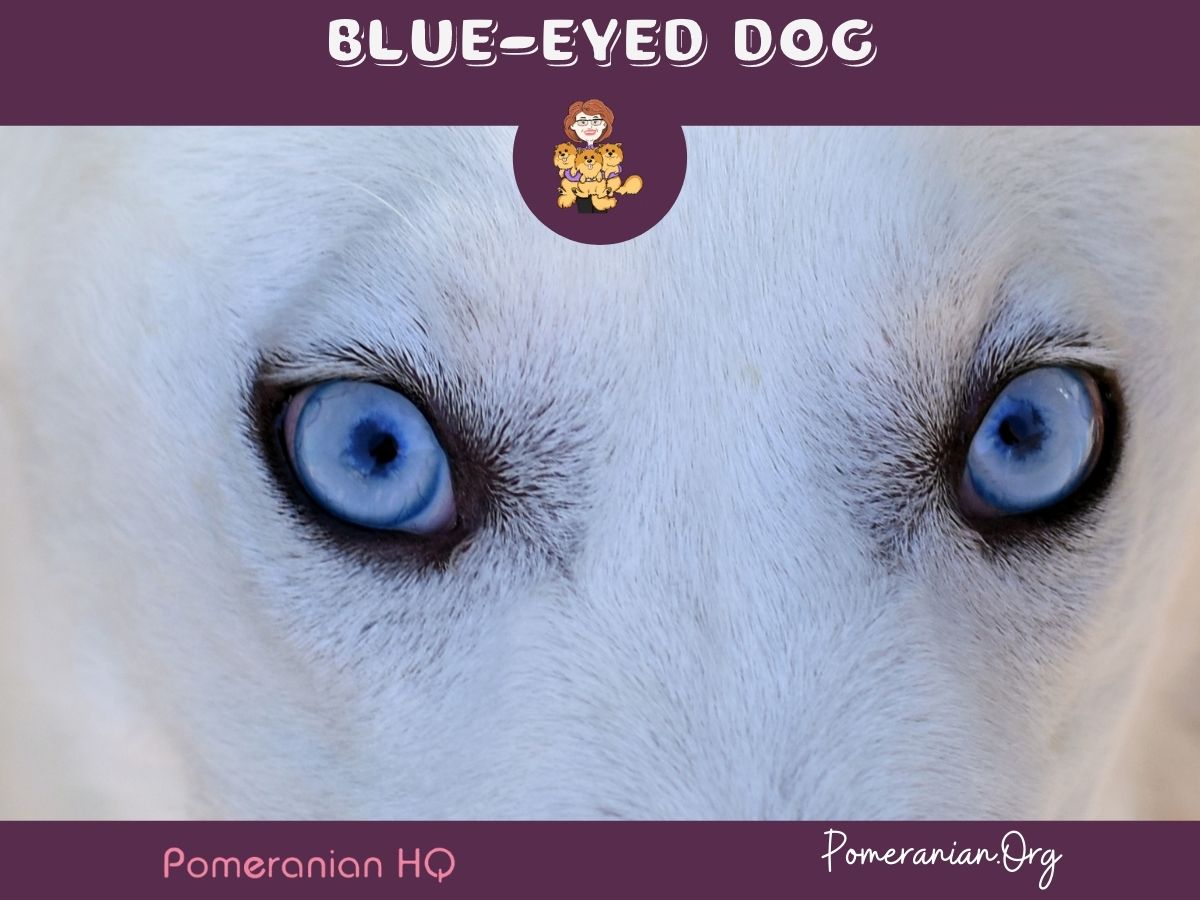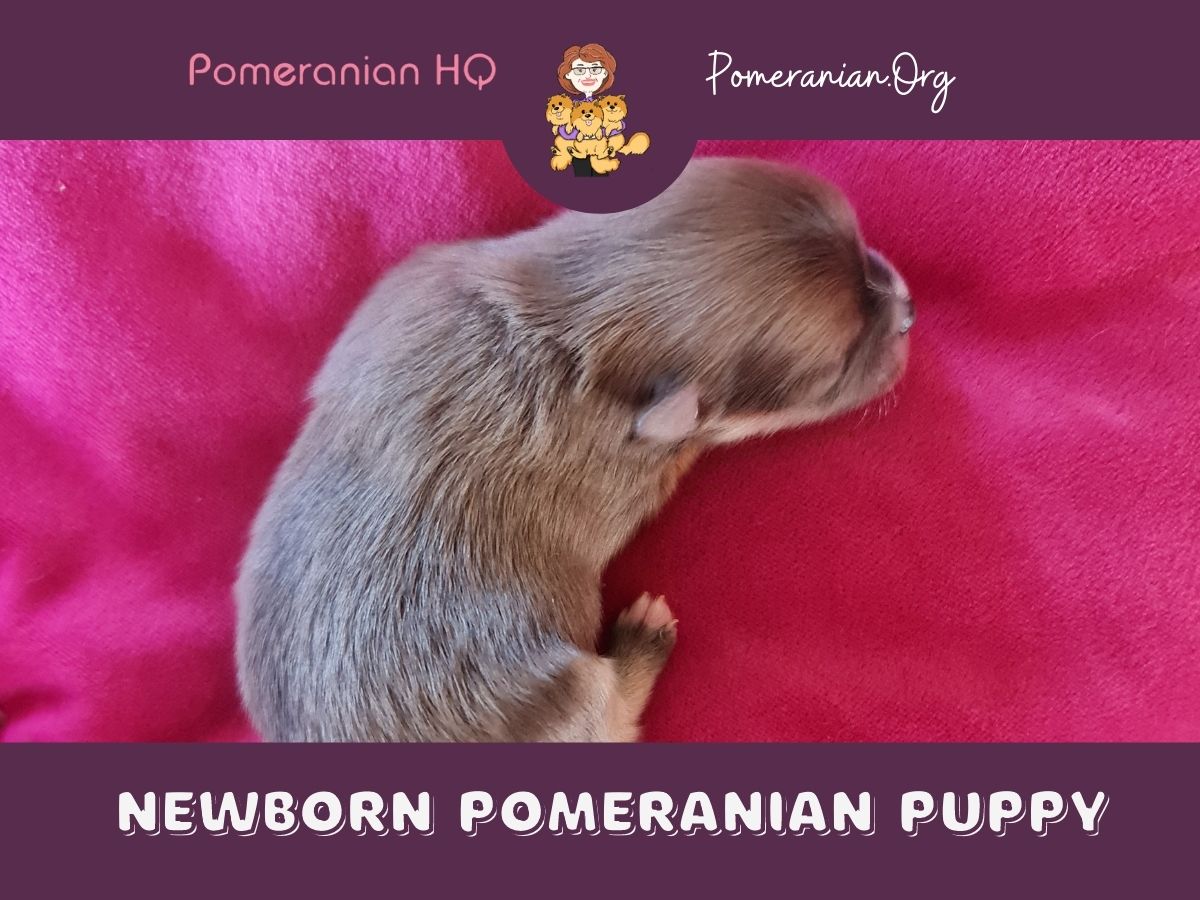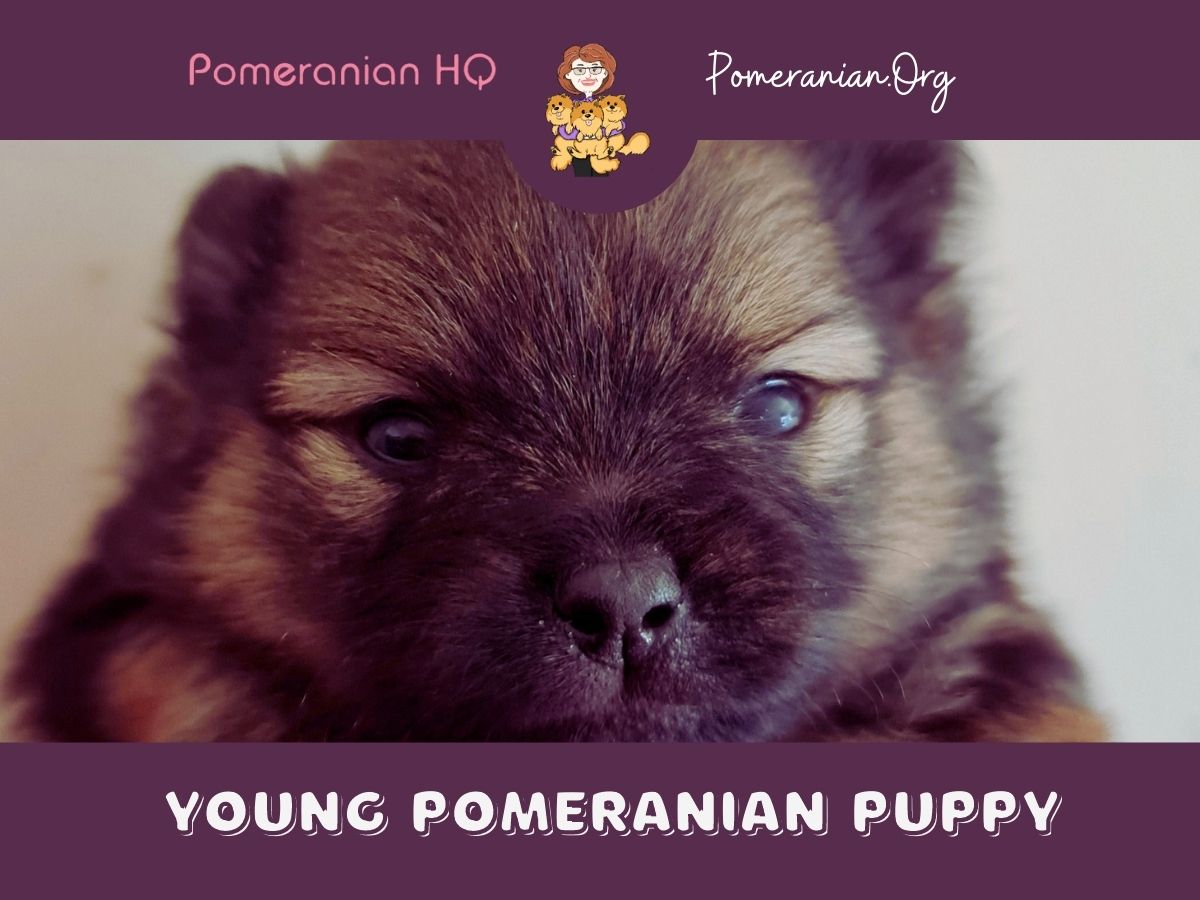Last Updated on 24/04/2024 by Dochlaggie. Post first published on May 11, 2022.
All about the blue-eyed Pomeranian dog. Can a Pomeranian have blue eyes and does a blue-eyed white Pomeranian exist? Learn the true facts:
Blue-eyed dogs are glamourous and intriguing. Pomeranians with blue eyes are even more attractive because they’re rare. This unique trait makes them even more stunning and can occur in purebred or mixed Pomeranians.
In this article, we’ll discuss everything you need to know about blue-eyed Pomeranians. Read in to learn more about blue-eyed Pomeranians.
Can Pomeranians Have Blue Eyes?
Yes, Pomeranians can have blue eyes but in very rare cases. In general, Poms which are not merle Pomeranians do not have the genes of blue eyes and hence it is very rare.
Genetic mutation can cause a Pom to have those rare beautiful blue eyes. But, in some cases, it might mean that the Pom has vision or hearing problems.
Blue eyes are more common among Pomeranians that have multi-colored bodies. Blue eye color can be expected if the Pom has merle color pattern genetics for its coat.

What is the Eye Color of a Normal Healthy Pomeranian?
Most of the Pomeranians have naturally occurring brown eyes. Brown eye color is dominant over other colors. If a Pom has blue eyes, you can be sure that there is a dilute color somewhere in the bloodline.
Let’s first look at what kennel clubs state in their Pomeranian breed standards:
AKC (American Kennel Club): “Dark, bright, medium-sized, and almond-shaped; set well into the skull with the width between the eyes balancing the other facial features. Eye rims are black, except self-colored in chocolate, beaver, and blue.”
KC (The Kennel Club of the United Kingdom: “Medium size, slightly oval, not full, or set too wide apart; bright, dark and showing great intelligence.”
CKC (Canadian Kennel Club): “The eyes should be medium in size, rather than oblique in shape, not set too wide apart, or too close together, bright and dark in colour.”
Though the breed standards clearly define Pomeranian eyes to be dark, the kennel clubs do accept self-coloring eyes with Pomeranians. For diluted coats, the eyes may ‘match’ the color of the points. Points refer to eyes rims, nose, lips, and feet pads.
The American Kennel Club breed standard lists blue eyes as a disqualifying breed fault.
Let’s take a look at some of the eye colors that Pomeranians have:
- Dark brown eyes: Most of the Pomeranians have dark brown eye colors. Brown color for eyes is dominant over other eye colors. So, if one Pom parent has dark brown colored eyes, the puppy is most, likely to have dark brown colored eyes as well.
- Medium brown and light brown eyes: Medium brown and light brown eyes have slightly less melanin than those with dark brown eyes.
- Blue: Pomeranians will have very dark blue eyes, which appear nearly black. A Blue Pomeranian is a diluted black dog.
- Green or hazel eyes: Pomeranians can have green or hazel eyes but this is rare. These eyes are seen in Poms that have chocolate, chocolate sable, and beaver-colored fur coats. Solid-colored Pomeranians other than the colors mentioned with green or hazel eyes are very rare.
- Odd eyed: This is when each eye is a different color. Some refer to this as ‘parti’ eyes or Heterochromia.
Pomeranians are born with their eyes closed. The eyes will open around the second week after birth. usually from day 10 to day 18 in small toy breed dogs like the Pomeranian.
The eye color of these young puppies will naturally darken as the puppy ages and their melanin levels increase. If your Pom puppy has just opened its eyes and the eyes are a bluish color, it should turn into its natural dark color eyes in the coming weeks.

The Eye Color of Pomeranian Puppies
You might be surprised to know that Pomeranian puppies are born with their eyes closed. When these eyes first open they might look a blue color.
The reason why Pomeranian puppies have dark bluish eyes when very young is due to a low level of melanin in the eyes. Melanin gives the eyes color; the more there is, the darker the eyes. Melanin increases as the Pom puppy grow up and their eyes start to turn into their natural color.
As the Pomeranian pup grows, the melanin slowly increases and causes the eyes to darken to brown. The eyes usually transition into their full natural color as the puppy becomes 6-7 weeks old. So, the change over from dark blue to brown eyes is complete before the age of 8 weeks old.
How Rare is a Pomeranian with Blue Eyes?
The blue color in the eyes is hereditary. Pom puppies are can have blue eyes if it’s passed down from their parents. However, if one of their Pomeranian parents has dominant brown-colored eyes, then the likelihood of having blue-colored eyes is minimized.
A Pomeranian with blue eyes is not rare amongst the merle Pomeranians.
There’s not an exact percentage or number of how many Poms have blue eyes, but the trait is exceedingly uncommon in the orange and orange sable colored Pomeranians.

Are Pomeranians with Blue Eyes Purebred?
Pomeranians with blue eyes can be purebred merle Pomeranians or mixed dogs. This trait is much more common in hybrid Poms if mixed with a Husky as these dogs can naturally have blue eyes. However, a purebred Pomeranian can have light brown, dark brown, hazel, or blue eyes without another breed in the mix.
What Causes Blue Eyes in Pomeranians?
The eye color for Pomeranians depends on both parents. The genes that cause blue eyes in Pomeranians can be recessive or dominant. This means that a Pom can inherit one or two copies of the gene to have blue eyes.
In the recessive version, if a Pomeranian only inherits one copy, then the Pom will have brown eyes. Brown eyes are dominant in Pomeranians.
- Heterochromia
Heterochromia or two different colored eyes can be caused by the Merle gene, loss of pigmentation, or just breed-specific genes.
- White patches of fur on the face
White patches of fur around Pom’s face can also create blue eyes. Pomeranian fur is unable to produce pigmentation around those areas, and the eyes are also affected. So, Pomeranians with dominant patches of white fur on their face have the potential to create blue eyes.
- Puppies with blue eyes
All young Pomeranian puppies are born with their eyes closed. When the eyes open they often appear very blurry and to be varying shades of blue eyes are often confusing to new breeders. Some appear to be a grayish green-blue while others may have blue with spots of brown.
Albino Pomeranians
Albino dogs show a massive loss of pigment throughout their entire body. The albino Pomeranians lack melanin pigment causing skin, hair, and eyes to be darker.
Albino Pomeranians have a severe lack of melanin, resulting in a pink to red eye color, regardless of the breed. There exist Albino Pomeranians with blue eyes but they are very, very rare.
Do All Merle Pomeranians Have Blue Eyes?
No, the merle gene does not always cause blue eyes. The merle gene causes the lightening of pigment in patches throughout the body.
Merle patterns consist of splatters of different colors and patterns. The merle gene in Pomeranians creates mottled patches of color in a solid or piebald coat and can affect skin pigment as well. The merle gene that modifies the coat color may also alter the eye and eye rim colors.
Merle is an accepted coat color in Pomeranians. The merle gene is a random gene that causes a ‘splattering’ effect on the coat and can also affect the eyes.
The merle gene modifies the dark pigment in Pomeranian eyes, occasionally changing dark eyes to blue, or part of the eye to be colored blue. Since merle causes random modifications, both dark-eyed, blue-eyed, and odd-colored Pomeranian eyes are possible.
In some cases, it will cause the Pomeranian to be odd-eyed which means having two different colored eyes. This only occurs when there are merle genes at play.
That gene splatters color and while it will do this to the coat, it can do this to one or both eyes. With Pomeranians that have this feature, vision is normal and there are no increased occurrences of cataracts

What Does it Mean If Your Pomeranian’s Eyes are Turning Blue and Cloudy?
If you believe your dog’s eye color is changing to blue, this might signal a problem. With cataracts and other eye diseases, the eye may take on a cloudy blue hue.
There are several conditions that cause a dog’s eyes to appear bluish. If your Pomeranian’s eyes have turned blue and cloudy from their normal color, these might be the causes:
- Nuclear Sclerosis
Nuclear Sclerosis is common in older Pomeranians and happens due to the hardening of eye lenses with age. This can cause your Pom to have cloudy and bluish-grey eyes. It might affect their vision to some extent but your Pomeranian should be able to adapt to it.
- Corneal Dystrophy
Corneal Dystrophy causes damage to the dog’s cornea. It is somewhat a common condition that won’t harm the vision but can affect both the eyes and turn them bluish.
- Cataract
Cataracts would usually develop a cloudy eye which would make the vision blur and ultimately can lead to a loss of vision. Cataracts can happen in Pomeranians as they age. If left untreated, it can cause eventual blindness.
Blue and cloudy eyes are usually a sign of some kind of problem with your Pomeranian’s eyes. If you notice a color change in your Pomeranian’s eyes, it is recommended that you take your Pom to a vet for a professional checkup.
Health Issues Associated with Blue Eye Color
Some pet parents might be concerned that blue eyes in Pomeranians cause additional health concerns. But are blue eyes in the Poms really a health concern?
Blue eyes in Pomeranians aren’t a health concern because they don’t cause any detrimental effects on the adorable little dog. These lovely dogs are just as healthy as the standard brown-eyed Pomeranians. Their health predictability is based on their genetics, diet, activity, and affection.
There’s no need to worry about your Pomeranian blue eyes having a long-term effect on their health. It won’t impact their energy levels or anything else.
The Merle gene can also cause blue eyes in Pomeranians. When two Merle carrier Pomeranians, also known as double merle, are crossed, the resulting litter is at a substantially higher risk of being deaf, blind, or both.
Breeding two Merle gene carriers are therefore not recommended and deemed inhumane. Blue-eyed Poms with double merle genes are more likely to have vision problems and other health issues. Here’s why:
- Blue eyes in Pomeranians have been linked to blindness.
- Dogs with light eyes, from lack of pigment, may also experience hearing sensitivity.
- Blue-eyed dogs are also more susceptible to sunburn and other forms of skin cancer.
- They may also have trouble seeing in low light conditions.
Get your dog to the vet right away if this has started since going untreated can cause eventual blindness. Many of these health problems can be avoided by not breeding two Poms with blue eyes together.
How to Take Care of Blue-Eyed Pomeranians
You must know that blue-eyed Poms can be more prone to health problems than other breeds. Some common problems include vision problems, sensitivity to light, and skin allergies. Here are some steps to protect your dog’s eyes from damage.
- The first thing you need to do is to visually inspect your Pomeranian’s eyes. The eyes should be clear and bright, with no exceptional amount of discharge.
- Keep their eyes clean. Weekly eye cleanings with warm water and eye drops can help most blue-eyed Poms.
- Protect your dog’s eyes during bathing time. Use bath products designed specifically to be safe for dogs.
- Feed them the right food. Look for foods that are high in antioxidants to help protect your dog’s eyes.
- Protect them from direct sun.
- Look for signs of eye problems. Redness, tearing, dryness, or irritation are common signs that something isn’t right.
And finally, if you’re ever in doubt about your Pomeranian’s eye health, please consult your vet for advice.

Final Thoughts on the Blue-Eyed Pomeranian
The Pomeranian is truly a delight to own. All Pomeranians’ eyes are unique and special. So, it turns out that Poms have blue eyes but the eye color is very rare. While most Poms are born with dark blue eyes, their eyes get darker as they turn 4 to 6 weeks old.
Blue eyes in Pomeranian puppies are unpredictable and difficult to produce. They should be seen as rare gems rather than defective dogs, though! These gorgeous Pom pups will undoubtedly enjoy a home full of interaction, love, and affection!
Copyright Pomeranian.org. All Rights Reserved.
References and Further Reading:
[1] Official Standard of the Pomeranian (AKC). American Kennel Club, 2011.
[2] English Kennel Club Pomeranian Breed Standard, 2017.
[3] Denise Leo, The Pomeranian Handbook.
[4] Milo G. Denlinger “The Complete Pomeranian.”
[5] Kimbering Pomeranians “1891-1991”.
[6] William Taplin’s “The Sportsman’s Cabinet.”
[7] E. Parker “The Popular Pomeranian.”
[8] Lilla Ives “Show Pomeranians.”








